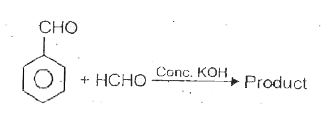In dehalogenation reaction of dihalides to get alkenes, the dihalide to be taken is
Gem dihalide
Vicinal dihalide
Isolated dihalide
Any dihalide
The correct Answer is:B
To solve the question regarding the dehalogenation reaction of dihalides to obtain alkenes, we will analyze the types of dihalides and their behavior in this reaction.
1. Understanding Dihalides:
- Dihalides are compounds that contain two halogen atoms attached to carbon atoms. They can be classified into different categories based on the position of the halogen atoms.
2. Types of Dihalides:
- Geminal Dihalides: Both halogen atoms are attached to the same carbon atom. For example, in a compound like CH3CBr2H, the two bromine atoms are on the same carbon.
- Vicinal Dihalides: The halogen atoms are attached to adjacent carbon atoms. For example, in 1,2-dibromoethane (CH2Br-CH2Br), the bromine atoms are on adjacent carbons.
- Isolated Dihalides: The halogen atoms are separated by more than one carbon atom. For example, in 1,3-dibromopropane (CH2Br-CH2-CH2Br), the bromine atoms are not adjacent.
- Any Dihalide: This term refers to any dihalide without specifying the arrangement of halogens.
3. Dehalogenation Reaction:
- The dehalogenation reaction typically involves the removal of halogen atoms from a dihalide to form an alkene.
4. Analyzing the Types of Dihalides:
- Geminal Dihalides: These do not readily undergo dehalogenation to form alkenes because both halogens are on the same carbon, making it difficult to eliminate them.
- Vicinal Dihalides: These are the most suitable for dehalogenation because the halogens are on adjacent carbons, allowing for the formation of a double bond between those carbons upon elimination of the halogens.
- Isolated Dihalides: These are less likely to form alkenes through dehalogenation since the halogens are not adjacent.
- Any Dihalide: This option is too broad and does not specify the necessary conditions for the reaction.
5. Conclusion:
- The correct choice for the dihalide to be used in the dehalogenation reaction to obtain alkenes is the vicinal dihalide.
Final Answer:
In dehalogenation reactions of dihalides to get alkenes, the dihalide to be taken is vicinal dihalide.
- Dihalides are compounds that contain two halogen atoms attached to carbon atoms. They can be classified into different categories based on the position of the halogen atoms.
- Geminal Dihalides: Both halogen atoms are attached to the same carbon atom. For example, in a compound like CH3CBr2H, the two bromine atoms are on the same carbon.
- Vicinal Dihalides: The halogen atoms are attached to adjacent carbon atoms. For example, in 1,2-dibromoethane (CH2Br-CH2Br), the bromine atoms are on adjacent carbons.
- Isolated Dihalides: The halogen atoms are separated by more than one carbon atom. For example, in 1,3-dibromopropane (CH2Br-CH2-CH2Br), the bromine atoms are not adjacent.
- Any Dihalide: This term refers to any dihalide without specifying the arrangement of halogens.
- The dehalogenation reaction typically involves the removal of halogen atoms from a dihalide to form an alkene.
- Geminal Dihalides: These do not readily undergo dehalogenation to form alkenes because both halogens are on the same carbon, making it difficult to eliminate them.
- Vicinal Dihalides: These are the most suitable for dehalogenation because the halogens are on adjacent carbons, allowing for the formation of a double bond between those carbons upon elimination of the halogens.
- Isolated Dihalides: These are less likely to form alkenes through dehalogenation since the halogens are not adjacent.
- Any Dihalide: This option is too broad and does not specify the necessary conditions for the reaction.
- The correct choice for the dihalide to be used in the dehalogenation reaction to obtain alkenes is the vicinal dihalide.
In dehalogenation reactions of dihalides to get alkenes, the dihalide to be taken is vicinal dihalide.
Similar Questions
Knowledge Check
- Question 1 - Select One
In the reaction of hydrogen bromide with an alkene (in the absence of peroxides), the first step of the reaction is the ............. to the alkene.
Afast addition of an electrophilicBslow addition of an electrophileCfast addition of a nucleophilicDslow addition of a nucleophile - Question 2 - Select One
An alkyl chloride produces a single alkene on reaction with sodium ethoxide and ethanol. The alkene further undergoes hydrogenation to yield 2-methylbutane. Identify the alkyl chloride from amongst the following :
AClCH2CH(CH3)CH2CH3BClCH2CH2CH2CH3CClCH2CH(CH3)CH2CH3DCH3C(Cl)(CH3)CH2CH3
Reaction of alkenes with halogens is explosive in the case of
View SolutionWhat are vicinal dihalides? Give an example.
View SolutionIn the reaction

If one equivalent of each is taken, the major product will beView SolutionThe dehydrohalogenation of a 1, 1-dihalide results in the formation of an ...............
View SolutionGem dihalides on treatment with alcoholic KOH give
View SolutionIn the reaction with HCl, an alkene reacts in accordance with the Markovnikov's rule to give a product 1-chloro,1-methylcyclohexane. The possible alkene is
View Solution

